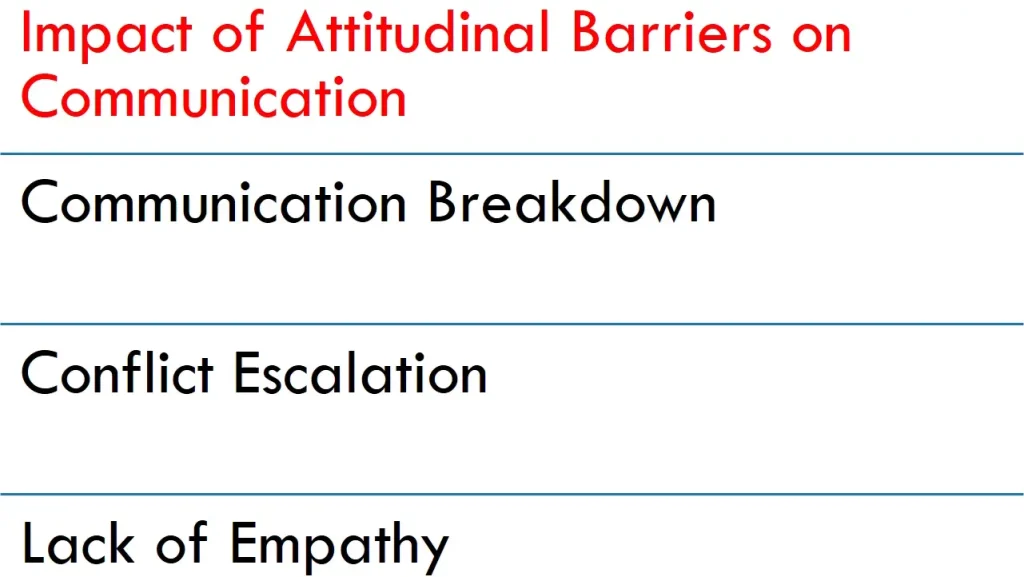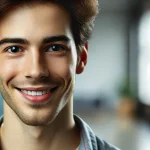Attitudinal barriers to communication arise when individuals let their personal attitudes, emotions, or prejudices obstruct effective interaction. These barriers can stem from negative perceptions or stereotypes about others.
These barriers, while intangible, can significantly impact interactions, be it in a learning environment or a workplace. From indifference and negativity to a lack of empathy, these hurdles can negatively affect academic performance and productivity. Recognizing and addressing these barriers is the first step to foster an atmosphere conducive to open-mindedness and respect.
Contents
Understanding Attitudinal Barriers to Communication
Attitudinal barriers are personal roadblocks that influence our perception and understanding of messages. Influencing our interactions in profound ways, these barriers often stem from our biases, personal attitudes, and ideologies. It’s essential to understand these barriers to foster a healthier learning environment.
Common examples of attitudinal obstacles include indifference, negativity, and lack of empathy. Recognizing such issues is often the first step in improving communication. By acknowledging the existence of these barriers, we can begin to actively work towards eliminating them.
When students face attitudinal barriers, it can negatively affect their academic performance. Interruptions in communication can lead to misunderstandings, low morale, and in some cases, can even escalate to conflicts. Recognizing and addressing these barriers is therefore crucial for creating a learning environment that is conducive to academic success.
| Barrier | Impact on Students |
|---|---|
| Indifference | Lack of Interest |
| Negativity | Lowered Morale |
| Lack of Empathy | Misunderstandings |
Building empathy and understanding is not only essential for communication but also for maintaining healthy interpersonal connections. One of the significant ways to overcome attitudinal barriers in communication is to promote empathy and understanding. Exercises that encourage students to appreciate diverse perspectives can be of enormous help in this aspect.
A productive learning environment hinges on the attitude of its participants. Fostering positive attitudes through effective communication strategies is therefore critical. When students are encouraged to maintain an open mind and a positive perspective, it contributes to a more harmonious learning atmosphere.
As we navigate the complex terrain of attitudinal barriers, we’re simultaneously cultivating clearer understanding and more robust interpersonal connections. It isn’t always easy, but with perseverance and commitment to open, empathetic communication, it’s surely manageable.
Types of Attitudinal Barriers

Attitudinal barriers, my own experience has shown, are very much a part of daily life. They exist not only in professional settings but also in our personal lives. Recognizing these barriers aids in improving communication, understanding, and overall team dynamics. Let’s identify a few key examples of these barriers.
Stereotyping
Stereotyping is a classic example of an attitudinal barrier. It’s an over-generalization of a person’s characteristics based on their perceived group or class. This can be based on various factors such as gender, generational group, physical characteristics, and even where they live or work. Such preconceived notions block effective communication and foster misunderstandings.
For instance, consider a small business scenario. Stereotyping might categorize people based on their work ethic, educational attainment, or department affiliation. This hampers open and constructive communication, dividing the team rather than unifying it. It highlights the need for treating individuals based on their unique qualities rather than sticking to generalized biases.
Prejudice
Prejudice is another major attitudinal barrier. It’s closely related to stereotyping but tends to involve more discriminatory or negative sentiments. Where stereotypes might partially base assumptions on observed trends, prejudice is often unfounded and primarily based on bias.
For those with disabilities, prejudice can be an ignored attitudinal barrier. Perceptions of helplessness and pity can plague their everyday interactions, limiting meaningful participation and communication. Such prejudiced notions hinder equal treatment, restricting opportunities for engagement and expression in personal and professional scenarios.
Ego
Ego, always a potential cause of conflict, can also create significant communication barriers. It manifests as egocentrism, placing our own ideas, opinions, and perspectives above those of others.
One example could be where an individual dominates group discussions, thinking their ideas hold more value than others. Their focus becomes centered on their viewpoint, causing interruptions or one-sided conversations. This approach limits the collective input, undermining the purpose of brainstorming and group discussions, which aim at gathering diverse perspectives for a more rounded solution.
Impact of Attitudinal Barriers on Communication
In this part of our discussion, we delve deeper into the impact of attitudinal barriers on the effectiveness of communication. Understanding the profound effect these barriers have on communication is vital. They can foster negative dynamics, disrupt learning and work environments, and even impact individuals’ interpersonal relations.

Communication Breakdown
Attitudinal barriers often result in the breakdown of communication. This is particularly evident in the context of resistance to change. People adverse to new ideas or methods tend to hinder open dialogue, causing communication lines to falter. As a result, productivity is hampered and innovation is stifled.
For instance, in a professional setting, if managers neglect employees’ input, it creates a barrier obstructing the seamless flow of vital information. This can lead to misinterpretations, misunderstandings, and an overall disconnect within an organization – a situation none of us want to find ourselves in.
Take another example, the loud noise in a busy factory can make understanding each other nearly impossible. The noise, a physical barrier, interrupts communication, leads to a disconnection between colleagues, and ultimately results in a failure to deliver the right message.
Conflict Escalation
Conflict is another inevitable result of attitudinal barriers to communication. Negative attitudes, such as pessimism or negativity, can quickly deplete the enthusiasm and morale of a team, leading to misinterpretations and unnecessary conflicts.
Interactions fraught with prejudice and stereotyping can cause individuals to feel marginalized reducing their motivation to communicate. This lack of communication further fuels conflict by nurturing a lack of understanding, and fostering misinterpretation and resentment.
Take a situation where employees are feeling anxious; they may misinterpret neutral statements into negative ones that lead to unnecessary conflict or misunderstanding. It becomes a vicious cycle that can be hard to break out of without conscious effort.
Lack of Empathy
The final key impact we’ll discuss here is lack of empathy. Attitudinal barriers sometimes arise from a lack of empathy in communication processes, thereby creating a hindrance to understanding and appreciating others’ perspectives.
In our day-to-day interactions, whether they’re at school, work, or home, those with a lack of empathy tend to view the world through a narrow lens. This can lead to misinterpretations and misconceptions, resulting in a breakdown in communication.
For example, individuals interpreting the tone of an email differently could be due to their unique perception, and this can lead to different emotional reactions. If there’s a lack of empathy all around, it can lead to a communication barrier that’s hard to overcome.
We must acknowledge these issues and work towards navigating them effectively. This is crucial in fostering a healthy and productive environment, whether it’s an academic setting or a professional one.
But hold on! We’re not done yet. We’ve looked at how attitudinal barriers affect communication. Now we need to explore effective strategies for dealing with these barriers, which we will be discussing in the next section.
Overcoming Attitudinal Barriers
Having identified the impacts of attitudinal barriers on communication, it’s time to explore the steps we can take to surmount these hurdles. Effective strategies include cultivating self-awareness, practicing active listening, and building empathy.
Self-awareness
Building self-awareness is pivotal. I regularly reflect on my attitudes, identifying any biases I might harbor, and then recognize their potential impact on my interactions. Feedback is another invaluable channel for this introspection. It provides an external perspective on how my attitudes may shape others’ perceptions of me and affect our communication. So, I encourage openness and promote a feedback culture.
Let’s take a glance at some valuable strategies and how they contribute to more effective communication in the table below:
| Strategy | Why It Helps |
|---|---|
| Self-awareness | Identifies personal biases |
| Seeking Feedback | Refines personal communication style |
Active Listening
Active listening takes center stage when countering attitudinal barriers. It involves giving complete attention to the speaker, empathizing and, most importantly, trying to eliminate preconceptions. Body language—smiling, nodding, making eye contact—signal engagement, putting the speaker at ease. This fosters an environment where conversation flourishes, leading to more meaningful exchanges.
Now let’s add our new strategy to the table:
| Strategy | Why It Helps |
|---|---|
| Self-awareness | Identifies personal biases |
| Seeking Feedback | Refines personal communication style |
| Active Listening | Validates feelings and breaks misconceptions |
Empathy Building
Embracing empathy is undeniably significant. Engaging in exercises that encourage perspective sharing is a great place to start. This approach urges us to appreciate and understand diverse viewpoints and experiences, enhancing our communication potential. Additionally, it minimizes cultural misconceptions, making the way for clearer, more effective interactions.
Let’s finish our table with the newest addition:
| Strategy | Why It Helps |
|---|---|
| Self-awareness | Identifies personal biases |
| Seeking Feedback | Refines personal communication style |
| Active Listening | Validates feelings and breaks misconceptions |
| Empathy Building | Fosters deeper understanding |
Remember, we’re dealing with a continuous process. Attitudes evolve, and so should our strategies. As we pursue a journey of strong, transparent communication, these key tactics set us up for success.
Conclusion
So, we’ve navigated the terrain of attitudinal barriers in communication and explored the tools to overcome them. It’s clear that self-awareness, feedback, active listening, and empathy aren’t just buzzwords. They’re pillars that hold up effective communication. By practicing these, we can identify our biases, refine our communication style, validate others’ feelings, and foster understanding. Remember, communication isn’t a one-and-done deal. It’s an ever-evolving process that requires constant work and refinement. So, let’s keep pushing for better, clearer, and more empathetic communication. The payoff will be worth it.
Boko Ducky has over 10 years of experience in helping individuals and organizations improve their communication skills.



